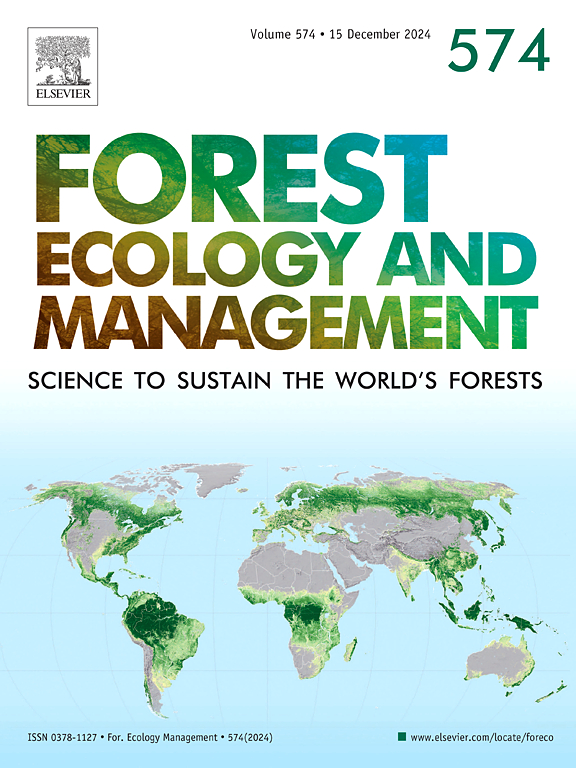Water table depth contributes to tropical Eucalyptus plantation yields in sandstone-derived landscapes
IF 3.7
2区 农林科学
Q1 FORESTRY
引用次数: 0
Abstract
Forest growth in tropical regions is regulated in part by climatic factors, such as precipitation and temperature, and by soil factors, such as nutrient availability and water storage capacity. We examined a decade of growth data from Eucalyptus clonal plantations from over 113,000 forest inventory plots across a 10 million-ha portion of Mato Grosso do Sul in southwestern Brazil. From this full dataset, three subsets were screened: 71,000 plots to characterize growth and yield across water table depth classes, 17,000 plots to build generalized models, and 50,000 plots for clone-based analyses. Average precipitation varied little across the region (1150 to 1270 mm yr−1), but water table depth ranged from less than 10 m to over 100 m. Where the water table was within 10 m of the surface, about 20 % of the total water used by trees came from this saturated zone. Water tables deeper than 50 m contributed very little to tree water use. Sites with a water table within 10 m averaged 47 m³ ha⁻¹ yr⁻¹ in stem growth (mean annual increment, MAI) across a full rotation, compared to less than 37 m³ ha⁻¹ yr⁻¹ for sites with water tables deeper than 50 m. Drought-induced canopy damage rose from 7 % to 30 % along the water tables depth gradient, while tree mortality rose nearly fourfold. The optimal stocking level was about 1360 trees ha−1 where water tables were accessible, declining to 1080 trees ha−1 where they were not. Among the 15 most planted Eucalyptus clones, increases in MAI from the lowest to highest water table depths ranged from + 4.8 to + 16.8 m³ ha⁻¹ yr⁻¹ , reflecting significant genotype-environment interactions. On average, MAI decreased by 0.8 m³ ha⁻¹ yr⁻¹ (ranging from 0.4 to 1.4) for every 10 m increase in water table depth. Similarly, the Site Index at base age 7 years declined from 31 m to 27 m, with an average reduction of 0.25 m per 10 m increase in water table depth. Physiographic modeling of water table depths offers useful information for forest management practices like forest inventory and planning, clonal allocation, optimized planting densities, fertilization strategies, coppice techniques, and other landscape-specific strategies like tree breeding zones.
地下水位深度对砂岩衍生景观中热带桉树人工林的产量有影响
热带地区的森林生长在一定程度上受气候因素(如降水和温度)和土壤因素(如养分供应和蓄水能力)的调节。我们研究了巴西西南部南马托格罗索州1000万公顷土地上11.3万多块森林清查样地的桉树无性系人工林十年来的生长数据。从这个完整的数据集中,筛选了三个子集:71,000个地块用于表征不同地下水位深度类别的生长和产量,17,000个地块用于建立广义模型,50,000个地块用于基于克隆的分析。区域平均降水量变化不大(1150 ~ 1270 mm yr−1),但地下水位从小于10 m到超过100 m不等。地下水位在地表10 米以内的地方,树木使用的总水量的20% %来自这个饱和区。深度超过50 m的地下水位对树木用水的贡献很小。网站内水位10 m平均47 m³ ha⁻¹ 年⁻¹ 茎增长(年平均增量,MAI)一个完整的旋转,而不到37 m³ ha⁻¹ 年⁻¹ 网站与地下水位深度超过50 m。沿地下水位深度梯度,干旱引起的冠层损害从7 %上升到30 %,树木死亡率上升了近4倍。在地下水位可达的地方,最佳放养水平约为1360树ha - 1,而在地下水位不可达的地方,最佳放养水平为1080树ha - 1。在15个种植最多的桉树无性系中,MAI从地下水位最低到最高的增加范围从+ 4.8到+ 16.8 m³ ha yr⁻¹ ,反映了显著的基因型与环境的相互作用。平均而言,地下水位每增加10 米,MAI就会减少0.8 m³ ha yr⁻¹ (范围从0.4到1.4)。同样,7年基龄时的Site Index从31 m下降到27 m,每增加10 m,平均减少0.25 m。地下水位的地理模型为森林管理实践提供了有用的信息,如森林清查和规划、无性系分配、优化种植密度、施肥策略、灌木林技术和其他景观特定策略,如树木繁殖区。
本文章由计算机程序翻译,如有差异,请以英文原文为准。
求助全文
约1分钟内获得全文
求助全文
来源期刊

Forest Ecology and Management
农林科学-林学
CiteScore
7.50
自引率
10.80%
发文量
665
审稿时长
39 days
期刊介绍:
Forest Ecology and Management publishes scientific articles linking forest ecology with forest management, focusing on the application of biological, ecological and social knowledge to the management and conservation of plantations and natural forests. The scope of the journal includes all forest ecosystems of the world.
A peer-review process ensures the quality and international interest of the manuscripts accepted for publication. The journal encourages communication between scientists in disparate fields who share a common interest in ecology and forest management, bridging the gap between research workers and forest managers.
We encourage submission of papers that will have the strongest interest and value to the Journal''s international readership. Some key features of papers with strong interest include:
1. Clear connections between the ecology and management of forests;
2. Novel ideas or approaches to important challenges in forest ecology and management;
3. Studies that address a population of interest beyond the scale of single research sites, Three key points in the design of forest experiments, Forest Ecology and Management 255 (2008) 2022-2023);
4. Review Articles on timely, important topics. Authors are welcome to contact one of the editors to discuss the suitability of a potential review manuscript.
The Journal encourages proposals for special issues examining important areas of forest ecology and management. Potential guest editors should contact any of the Editors to begin discussions about topics, potential papers, and other details.
 求助内容:
求助内容: 应助结果提醒方式:
应助结果提醒方式:


